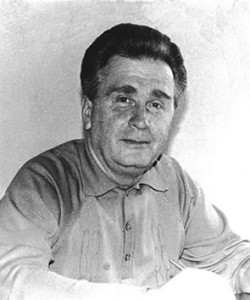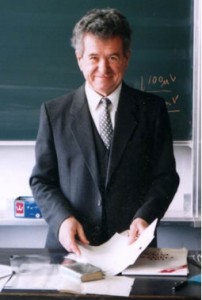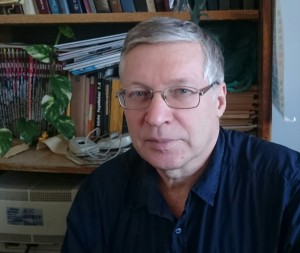After the Physics and Technology Faculty was established in December 1972, the training of students in cryogenic engineering began in September 1973. The first were volunteers from the specialty “Physics of Metals”: group FT-21 – 10 people, group FT-22 – 16 people, and the first applicants were accepted to the first year in the amount of 25 people – group FT-23.
The training of students in the specialty “Cryogenic Engineering and Technology” (before 1989 – “Cryogenic Engineering”) takes place at KhPI and on the basis of the Low Temperature Physics and Engineering Institute of the Academy of Sciences of Ukraine (LTPE). The Department of Technical Cryophysics was organized on August 31, 1977. The founders of the Department of Technical Cryophysics were academicians of the Academy of Sciences of Ukraine: Director of the Institute of Low Temperature Physics and Applied Mathematics Verkin B.I., Deputy Director Dmitrenko I.M., professors: Rector of the KhPI Semko M.F., Vice-Rector Kirkach N.F., Dean of the Faculty of Physical Technology, Associate Professor Sapelkin N.P. The head of the Department of Technical Cryophysics was the leading employee of the OKTB ILTPE, a specialist in the calculations of complex cryogenic systems Anatoly Grigorievich Podolsky.
After 2 years, a branch of the department was created at the Institute of Low Temperature Physics and Applied Mathematics, headed by Corresponding Member of the Academy of Sciences of Ukraine Dmitrenko Igor Mikhailovich. Together with Anatoly Grigorievich, he was actively involved in the development of the educational process at the department. At that time, the physical and mathematical training of cryogenics specialists was laid down, which was not inferior to the academic university training.
A few years later, cryophysics engineers began to flow in a continuous stream into the departments and laboratories of the Institute of Low Temperature Physics and Applied Mathematics. Engineering training gave them an advantage over graduates of KhSU. This was the great merit of Prof. Podolsky A.G.He was well aware of the changes taking place in the economy in recent years and adjusted the curricula in a timely manner. This made it possible, without reducing the requirements for fundamental training, to organize the training of engineers in the field of modern low-temperature technologies.
A significant contribution to the educational process was made at different times by academicians Dmitrenko I.M., Kulik I.O., Corresponding Member Zvyagin A.I., Professors Mikhalchenko R.S., Galayko V.G., Eselson B.N., Kirichenko Yu.A. and research associates of the Institute of Low Temperature Physics and Technology Musienko L.E., Zhitomirsky I.S.
Professor Podolsky A.G. made a great contribution to the founding of the main scientific direction of the department – mathematical modeling of non-stationary thermophysical processes of low-temperature systems. Mathematical models of gas machines were used in the organizations Microcryogenmash OKTB FTINT NASU, Geliymash for the design of cryogenic systems that were used in space technology and the military-industrial complex. The models developed by him and his students were used to manufacture cooling systems for the Tokamak magnetic system (UPTI), various products, etc. Students of the specialty took an active part in these works.
Over the past years, a qualified team of teachers has been formed at the department – professors – Lubyany L.Z., Falko I.I., Kukharenko V.N., Zhun G.G., Ph.D. senior lecturer – Rudenko N.Z. The team was replenished with graduates of the specialty: senior lecturers Overko N.E. and Yushko S.V.
From 1977 to 2015, about 800 specialists were trained, of which 90 people received diplomas with honors. 90 graduates were sent to work at FTINT.In Kharkov and the region, 50 to 90% of graduates were distributed: FTINT, KHIPTI, IPPKiK, IRE, Research Institute of the Electrotyazhmash Plant, Monolith Plant, Refrigeration Machines, etc. In Ukraine, the distribution was about 90% of the graduates: the cities of Mariupol, Melitopol, Dnepropetrovsk, Krivoy Rog, Shostka, Sumy, etc.
 From 2004 to 2008, the department was headed by Vladimir Mikhailovich Svistunov, professor, doctor of physical and mathematical sciences, Laureate of the State Prize in Science and Technology. Over the years of his scientific and pedagogical activity, V.M. Svistunov published over 180 articles in leading domestic and international journals. He has three author’s certificates, review (commissioned) articles in the journal “Advances in Physical Sciences” and in a number of leading foreign publications. Professor V.M. Svistunov (with his student, PhD in Physics and Mathematics M.A. Belogolovsky) published the monograph “Tunnel Spectroscopy” (1986, Kyiv “Naukova Dumka”); prepared and published the translation from English of the book by Wolf E. (USA) “Principles of Tunnel Spectroscopy” (1990, Kyiv “Naukova Dumka”).
From 2004 to 2008, the department was headed by Vladimir Mikhailovich Svistunov, professor, doctor of physical and mathematical sciences, Laureate of the State Prize in Science and Technology. Over the years of his scientific and pedagogical activity, V.M. Svistunov published over 180 articles in leading domestic and international journals. He has three author’s certificates, review (commissioned) articles in the journal “Advances in Physical Sciences” and in a number of leading foreign publications. Professor V.M. Svistunov (with his student, PhD in Physics and Mathematics M.A. Belogolovsky) published the monograph “Tunnel Spectroscopy” (1986, Kyiv “Naukova Dumka”); prepared and published the translation from English of the book by Wolf E. (USA) “Principles of Tunnel Spectroscopy” (1990, Kyiv “Naukova Dumka”).
Under the supervision of Professor V.M. Svistunov, dissertations were prepared and defended by 15 candidates of physical and mathematical sciences (including two in Japan and Slovakia) and 3 doctors of physical and mathematical sciences – specialists in the field of solid state physics, low temperatures and high pressures. He created a scientific school that effectively works in the main areas of condensed matter physics.
The research of Professor V.M. Svistunov and his colleagues made a significant contribution to understanding the nature of tunneling phenomena, superconductivity and serves as an ideological basis for practical developments in the field of creating high-sensitivity electronic systems. His scientific results brought wide recognition to domestic science in this area, they are a priority for Ukraine.
F rom 2008 to 2012, the department was headed by Leonid Zakharovich Lubyany, PhD in Engineering, Professor of the department. Thanks to the laboratory research conducted by his group, the department has extensive experience in developing magnetometric devices, including those using nanostructured materials that are used to study the structure of biological geomagnetic fields, in navigation systems, as well as sensitive elements of scanning magnetic microscopes at low temperatures. Together with scientists from the Department of Physics of Metals and Superconductors, the physical foundations for creating highly sensitive multilayer magnetomodulation sensors of a new generation have been developed.
rom 2008 to 2012, the department was headed by Leonid Zakharovich Lubyany, PhD in Engineering, Professor of the department. Thanks to the laboratory research conducted by his group, the department has extensive experience in developing magnetometric devices, including those using nanostructured materials that are used to study the structure of biological geomagnetic fields, in navigation systems, as well as sensitive elements of scanning magnetic microscopes at low temperatures. Together with scientists from the Department of Physics of Metals and Superconductors, the physical foundations for creating highly sensitive multilayer magnetomodulation sensors of a new generation have been developed.
Since 2012, the department has been headed by Doctor of Physical and Mathematical Sciences, Professor Alexander Yuryevich Sipatov. Ov er the years of his scientific and pedagogical activity at our university, A.Yu. Sipatov has published over 130 articles on the topic of “Semiconductor nanostructures: synthesis, structure, properties.” Nanostructures are a new class of artificial semiconductor materials with a controlled band spectrum of charge carriers.By purposefully changing the composition and structure of nanomaterials, it is possible to predictably change their energy band structure and obtain unique physical properties that are unattainable for conventional crystals and films.
er the years of his scientific and pedagogical activity at our university, A.Yu. Sipatov has published over 130 articles on the topic of “Semiconductor nanostructures: synthesis, structure, properties.” Nanostructures are a new class of artificial semiconductor materials with a controlled band spectrum of charge carriers.By purposefully changing the composition and structure of nanomaterials, it is possible to predictably change their energy band structure and obtain unique physical properties that are unattainable for conventional crystals and films.
In the laboratory of semiconductor nanostructures (headed by prof. A.Yu. Sipatov), various types of nanostructures have been experimentally realized based on chalcogenide semiconductors (PbS, PbSe, PbTe, SnTe, YbS, YbSe, YbTe, EuS, EuSe, EuTe, SrS): 2D (superlattices, quantum wells), 1D (nanofibers), 0D (quantum dots), as well as dislocation nanonetworks [11]. Slide.
Superconductivity was discovered for the first time for dislocation nanonetworks [51, 70], which is associated with the presence of periodic nanoscale networks of misfit dislocations at the interfaces of semiconductor heterostructures (the absence of dislocations leads to the absence of superconductivity).
Luminescence spectra from quantum dots created by modulation of the structure by periodic dislocations along the interfaces and modulation of the composition in the orthogonal direction were discovered for the first time for PbSe-PbS superlattices [61].
 For PbTe quantum dots created on the basis of PbTe-PbS and PbTe-EuS heterostructures, shifts of the photoluminescence peaks towards higher energies by 80 and 30 meV relative to bulk PbTe are observed, which is in good agreement with the predictions for size quantization in 0D nanostructures.For 2D nanostructures (superlattices), resonant tunneling of electrons through ferromagnetic barriers of EuS [87] has been discovered, as well as antiferromagnetic ordering [12,46] of magnetic layers caused by their interaction through diamagnetic interlayers of PbS, YbSe and SrS. Such ordering is observed for an unusually large range of interlayer thicknesses of narrow-bandgap semiconductor PbS (0.4 – 40 nm), wide-bandgap YbSe and dielectric SrS (1 – 2 nm).
For PbTe quantum dots created on the basis of PbTe-PbS and PbTe-EuS heterostructures, shifts of the photoluminescence peaks towards higher energies by 80 and 30 meV relative to bulk PbTe are observed, which is in good agreement with the predictions for size quantization in 0D nanostructures.For 2D nanostructures (superlattices), resonant tunneling of electrons through ferromagnetic barriers of EuS [87] has been discovered, as well as antiferromagnetic ordering [12,46] of magnetic layers caused by their interaction through diamagnetic interlayers of PbS, YbSe and SrS. Such ordering is observed for an unusually large range of interlayer thicknesses of narrow-bandgap semiconductor PbS (0.4 – 40 nm), wide-bandgap YbSe and dielectric SrS (1 – 2 nm).
Since 2020, the Department of Science has been joined by Doctor of Physics and Mathematics. Sciences., Professor Starikov Vadim Volodimirovich. Working at the department of “Physics of Metals on Substances” at NTU KhPI, in 2018, he completed his doctoral dissertation on the topic “Synthesis, structure and power of biosumical spherical systems.”
